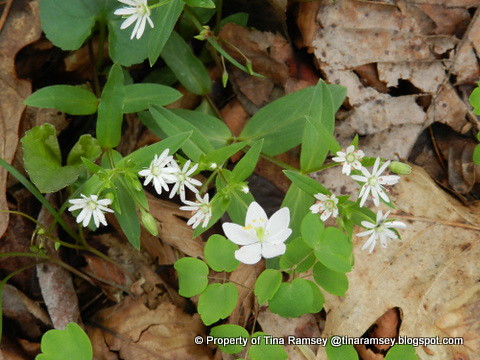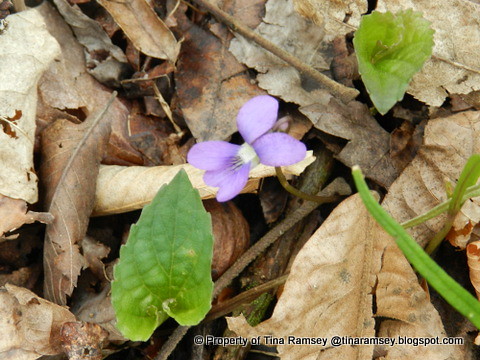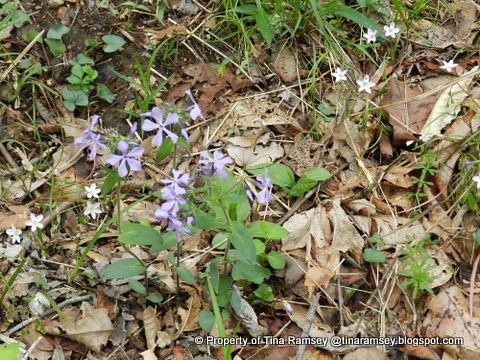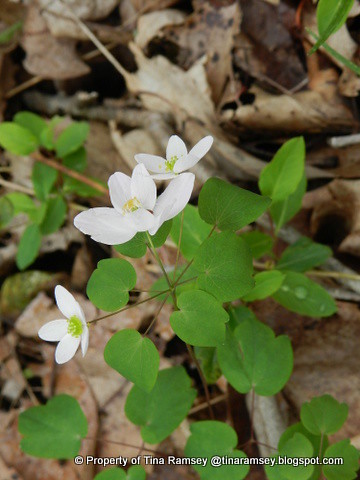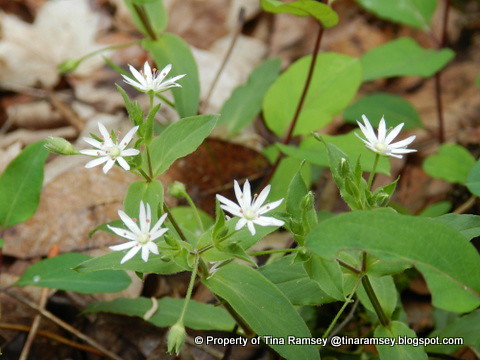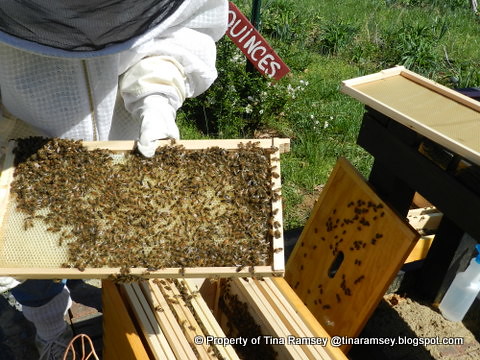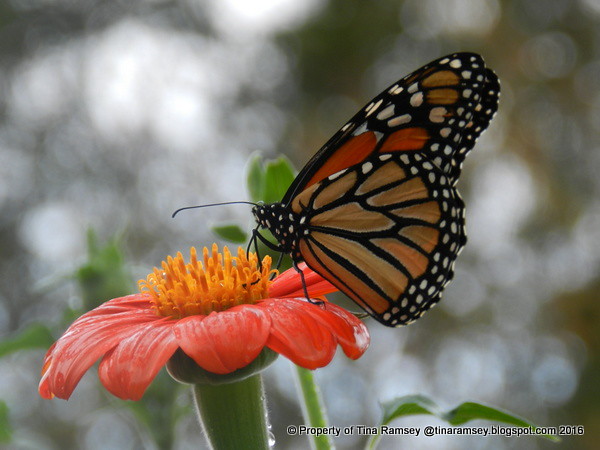 A recent walk around Tiger Way Gardens had me finding lots of neat fall colors. Above is a monarch sipping from a Mexican sunflower (Tithonia). Funny thing about Mexican sunflowers, I've never grown them before and don't really know where this one came from amongst the zinnias. I almost pulled it out but due to lazy weeding, it bloomed before it was doomed. That was a good thing! Monarchs love tithonias.
A recent walk around Tiger Way Gardens had me finding lots of neat fall colors. Above is a monarch sipping from a Mexican sunflower (Tithonia). Funny thing about Mexican sunflowers, I've never grown them before and don't really know where this one came from amongst the zinnias. I almost pulled it out but due to lazy weeding, it bloomed before it was doomed. That was a good thing! Monarchs love tithonias.
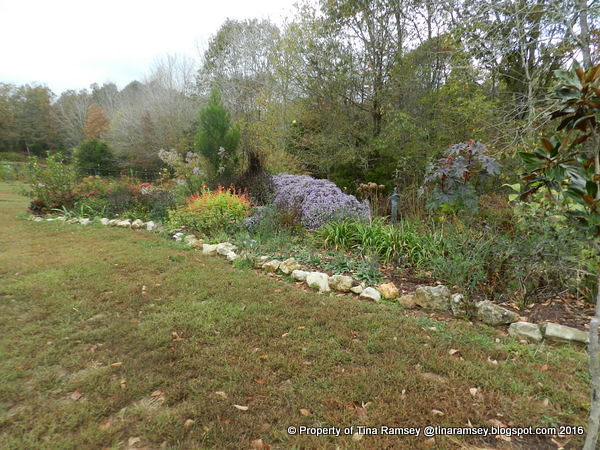 The front corner garden is outstanding in its fall glory. This garden never fails to please me. Except for the dastardly weeds (which thankfully you probably can't see too well from this angle).
The front corner garden is outstanding in its fall glory. This garden never fails to please me. Except for the dastardly weeds (which thankfully you probably can't see too well from this angle).
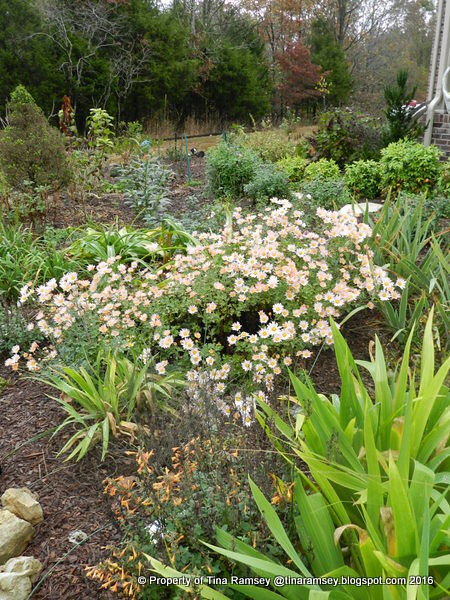 The Sheffies in the front foundation garden are putting on quite a show. Here they are paired with hyssop, spirea, and Japanese roof irises.
The Sheffies in the front foundation garden are putting on quite a show. Here they are paired with hyssop, spirea, and Japanese roof irises.
 Another garden has a bunch of Sheffies. Here they are paired with daylilies, 'Autumn Joy' sedum, and tall yellow garden mums.
Another garden has a bunch of Sheffies. Here they are paired with daylilies, 'Autumn Joy' sedum, and tall yellow garden mums.
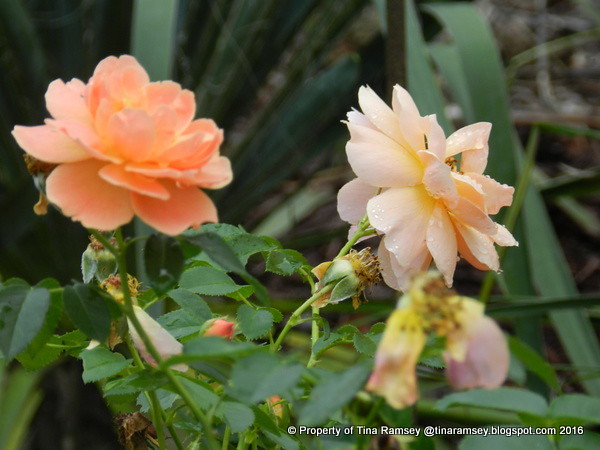 'At Last' rose is an AHmazing rose. It blooms and blooms, has a great rose scent, and does not get foliage diseases (at least in my garden this rainy summer).
'At Last' rose is an AHmazing rose. It blooms and blooms, has a great rose scent, and does not get foliage diseases (at least in my garden this rainy summer).
 My beloved glass mosaics are finally in their new home. I am very happy they survived the move, the subsequent storage, and then reinstallation. Considering these have been in the garden since 2009 that is fantastic!!
My beloved glass mosaics are finally in their new home. I am very happy they survived the move, the subsequent storage, and then reinstallation. Considering these have been in the garden since 2009 that is fantastic!!
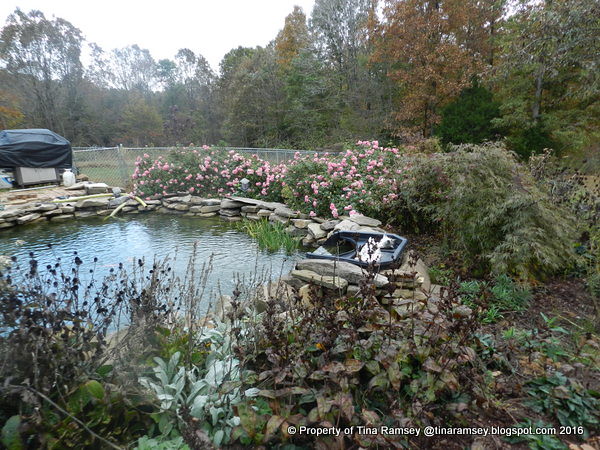 The koi pond with its surrounding pink garden is a highlight for me. All of the koi are active and eating well. We've not had a single issue with wildlife dining on the koi. Thank goodness!
The koi pond with its surrounding pink garden is a highlight for me. All of the koi are active and eating well. We've not had a single issue with wildlife dining on the koi. Thank goodness!
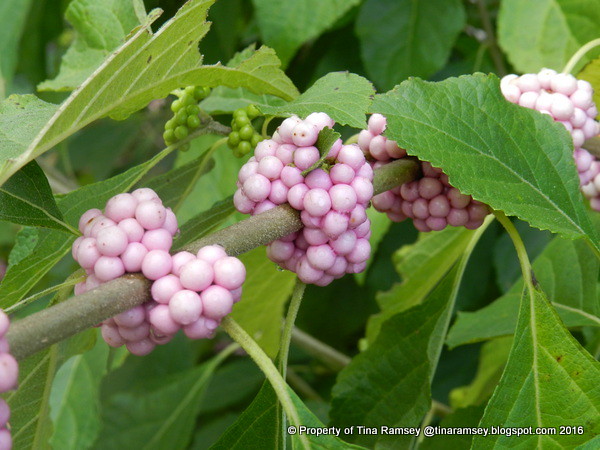 Beautyberry (Callicarpa bodinieri 'Profusion') is beginning to color up. This is a rather large shrub that continues to grow, flower, and fruit even with multiple prunings during the growing season. I like it a lot.
Beautyberry (Callicarpa bodinieri 'Profusion') is beginning to color up. This is a rather large shrub that continues to grow, flower, and fruit even with multiple prunings during the growing season. I like it a lot.
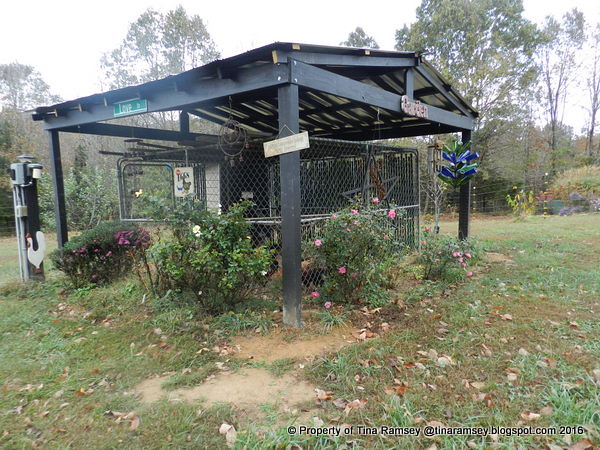 The chickens got a new roof over their run to keep them dry this winter. This was a long time coming project but it is mostly finished for now.
The chickens got a new roof over their run to keep them dry this winter. This was a long time coming project but it is mostly finished for now.
 Looking down the driveway along the south side of the orchard we see asters in the butterfly garden and lots of PG hydrangeas and grasses. The leaves are beginning to fall in earnest as well.
Looking down the driveway along the south side of the orchard we see asters in the butterfly garden and lots of PG hydrangeas and grasses. The leaves are beginning to fall in earnest as well.
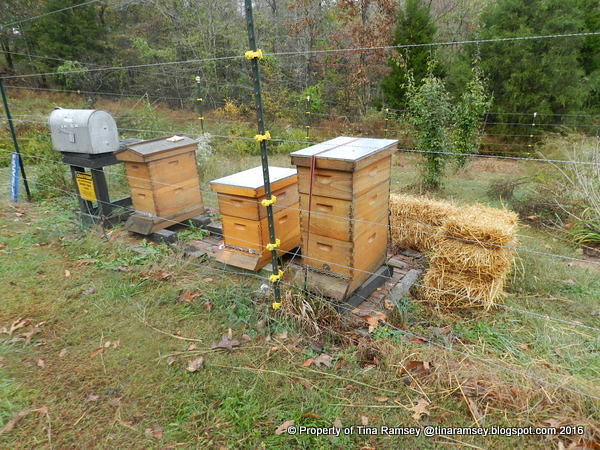 The beehives have had their mouseguards installed and I am in the process of hay baling the northwest side of the hives in order to block the cold north winds. I am most relieved to be mostly done with the bees until next spring.
The beehives have had their mouseguards installed and I am in the process of hay baling the northwest side of the hives in order to block the cold north winds. I am most relieved to be mostly done with the bees until next spring.
 Some of these PG hydrangeas are still showing new blooms but most have faded to the brown flowers they'll keep all winter. I love these as much for their winter interest as for their bloom in the summer.
Some of these PG hydrangeas are still showing new blooms but most have faded to the brown flowers they'll keep all winter. I love these as much for their winter interest as for their bloom in the summer.
 On the back 40 Wildflower Hill is doing its stuff. The broomsedge has turned brown and the trees are coloring up. We don't seem to get much fall color in Tennessee, especially when it has been dry, but some trees color up nicely. The short red tree is a native dogwood. These almost always have a lovely red fall color.
On the back 40 Wildflower Hill is doing its stuff. The broomsedge has turned brown and the trees are coloring up. We don't seem to get much fall color in Tennessee, especially when it has been dry, but some trees color up nicely. The short red tree is a native dogwood. These almost always have a lovely red fall color.
 The hickories in the foreground turn a russet color. I mowed a path down the hill and oftentimes this path beckons me to travel onwards.
The hickories in the foreground turn a russet color. I mowed a path down the hill and oftentimes this path beckons me to travel onwards.
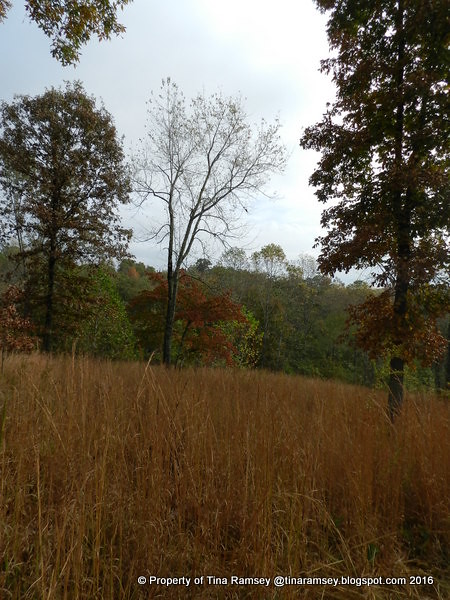 This is simply one of my favorite sights on the property.
This is simply one of my favorite sights on the property.
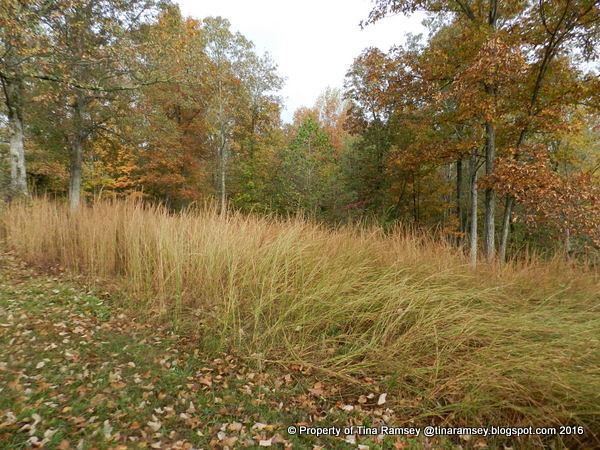 I mow the flat part of the crest of the hill and have planted numerous nut trees in this area.
I mow the flat part of the crest of the hill and have planted numerous nut trees in this area.
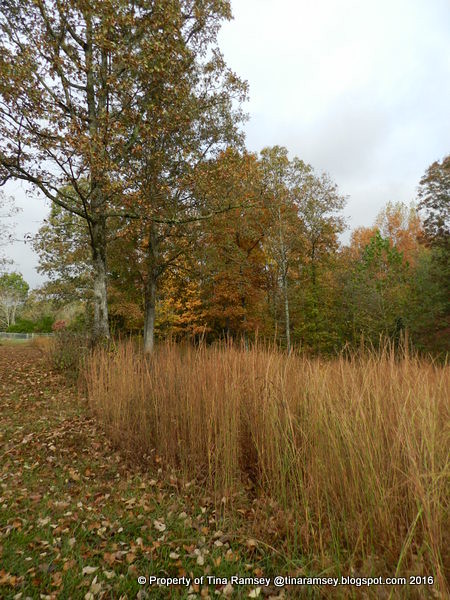 More of the russet hickory trees. Our forest is predominately Oak/hickory hardwoods and I try hard to maintain it thusly.
More of the russet hickory trees. Our forest is predominately Oak/hickory hardwoods and I try hard to maintain it thusly.
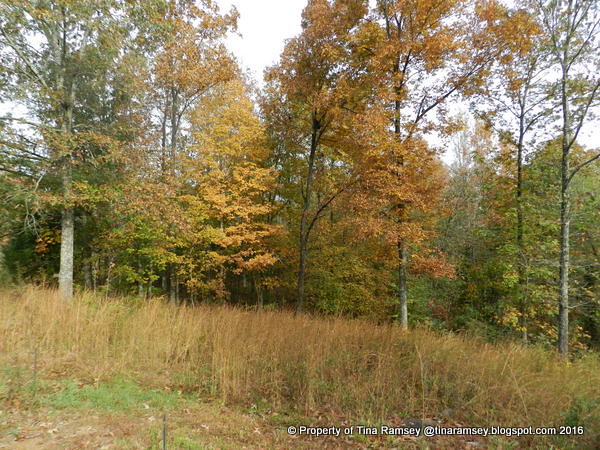 Some golds mix in with the russets.
Some golds mix in with the russets.
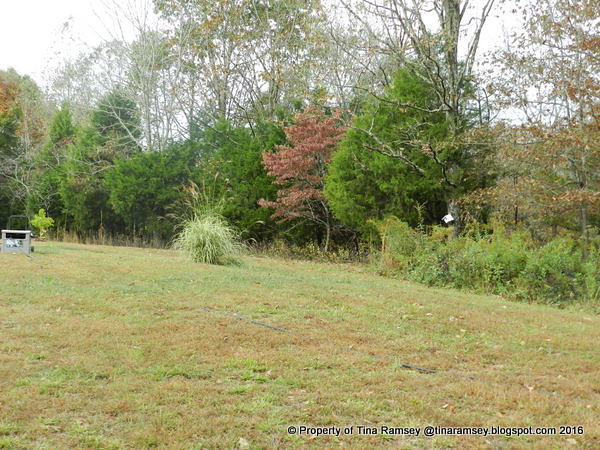 A dogwood and cedar stand mix well in this southern facing exposure.
A dogwood and cedar stand mix well in this southern facing exposure.
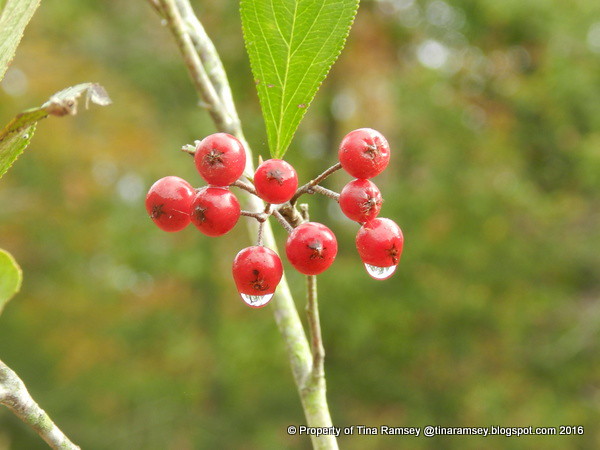 Aronia arbutifolia 'Brilliantissima', aka red chokeberry, is coloring up. These berries will persist all winter long as long as the wildlife does not find them.
Aronia arbutifolia 'Brilliantissima', aka red chokeberry, is coloring up. These berries will persist all winter long as long as the wildlife does not find them.
 I finish back at the house in a foundation garden. This is one of four 'Black Dragon' (Cryptomeria japonica) and they are finally getting their beautiful shape. I purchased four of these as markdowns two years ago. 'Black Dragons' can be very expensive but are so beautiful I had been on the lookout for them. All four are planted along the foundation corners in the front of my home. They are actually growing fairly quickly and once mature will make lovely counterpoints to the house. Additionally, since they are evergreen they provide year round interest.....
I finish back at the house in a foundation garden. This is one of four 'Black Dragon' (Cryptomeria japonica) and they are finally getting their beautiful shape. I purchased four of these as markdowns two years ago. 'Black Dragons' can be very expensive but are so beautiful I had been on the lookout for them. All four are planted along the foundation corners in the front of my home. They are actually growing fairly quickly and once mature will make lovely counterpoints to the house. Additionally, since they are evergreen they provide year round interest.....
in the garden......
I don't post as much as I used to, but I am fairly active on my Facebook page found here. I find it so much easier to be in the spur of the moment to post interesting things on FB with my smartphone rather than on the blog. So if you like Coach in the Garden and would like to keep up with the plant happenings in Tiger Way Gardens please check out and like my professional page...in the garden.
Words and Photos Property of In the Garden Blog Team, In the Garden
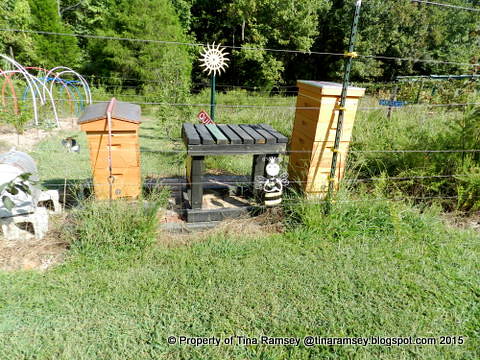 "I think you should go ahead and get some bees Tina. It will be good for you and fun." says Mr. Fix-it. I do love my husband and he is always considering my happiness in all he says and does but perhaps I was a bit disillusioned about beekeeping, and it is all his fault. My revenge is to ask him to help me with the bees. He has obliged willingly, but after he got stung once he is not so obliging anymore. That did not stop my hero from taking pictures during his lesson on beekeeping on this day. And lucky him he did not get stung! Maybe the bee thing will work out for us after all.
Prior to getting into beekeeping I heard a lot of good things about bees. The optimism of everyone I spoke to made me think bees would be easy to care for. As a benefit to beekeeping I would have ready pollinators in my garden and I'd be helping the bees. Hmmmmmm, this is the reality of beekeeping:
"I think you should go ahead and get some bees Tina. It will be good for you and fun." says Mr. Fix-it. I do love my husband and he is always considering my happiness in all he says and does but perhaps I was a bit disillusioned about beekeeping, and it is all his fault. My revenge is to ask him to help me with the bees. He has obliged willingly, but after he got stung once he is not so obliging anymore. That did not stop my hero from taking pictures during his lesson on beekeeping on this day. And lucky him he did not get stung! Maybe the bee thing will work out for us after all.
Prior to getting into beekeeping I heard a lot of good things about bees. The optimism of everyone I spoke to made me think bees would be easy to care for. As a benefit to beekeeping I would have ready pollinators in my garden and I'd be helping the bees. Hmmmmmm, this is the reality of beekeeping:
It's easy, you only need to spend about 15 minutes a week on beekeeping. Truth: It's more like 30-60 minutes or so per week for me and while that does not seem to be a long time, it really is a long time when in a bee jacket in 90 degree weather.
Bees make their own food. Truth: Yes and no. It all depends on what is blooming that the bees can eat. Even though there are flowers blooming the bees might not be able to use them for pollen or nectar. Case in point, goldenrod has been blooming for quite a while, but the bees apparently did not like the kind blooming and so they preferred to dine at my five hummingbird feeders. That was my clue to feed my bees. Now that the good goldenrod is blooming they've left the hummingbird feeders alone but they still don't seem to have enough to eat so everyone in bee groups says to feed. Feeding is difficult for a good deal of reasons. Not to mention it means I have to get in the hive. Urgh.
Bees are gentle and usually don't sting. Truth: Bees don't appreciate you opening up their house and rummaging around in it. They appreciate it even less when you want to take all their food away. Bees will sting to defend their homes. Who can blame them? If you are a beekeeper expect to get stung. The good news is bee stings are way less painful than a wasp sting and I've been stung by both this summer.
Bees will repay you in spades with honey. You might even get some the first year! Truth: I really had no intentions of harvesting honey this year. It's a good thing too! There really isn't any extra for me. I suspect I may be feeding my bees all winter and that is so not fun. Maybe at some point I'll get honey but each teaspoon will have costed me about $5. Haha, I could just as easily buy honey for a lot less money and let someone else do all the work.
You become one with nature when checking your beehives. Truth: I try ever so hard to really get into a groove and to enjoy checking the beehives. It's true the gentle hum of the bees can be lulling and it is kind of neat conversing with nature. As long as I can get past sweat running down my brow so much that I can't see to do things right and I don't bump a frame or the box and the bees get angry, then yes, becoming one with nature might take effect-might. In the meantime it is a lot of nervousness when in the beehives and not so much enjoyment of nature.
I have two hives because the best advice says to start with two hives. This way I (the beekeeper) can gauge how each hive is doing by comparing the two. In the above picture the hive on the right is doing a LOT better than the hive on the left. There are more bees and they have more stores in those extra boxes and this is amazing since the queen in this hive disappeared early on in the season. I actually had to requeen this hive which can set a hive back. The left hive should be in a better position because it has the original queen and was not set back like the other hive. That is, until I fed the bees and most of the bees in the left hive drowned in their nectar. None of the bees in the right hive drowned. What? Yes, bees are a quandary. Let's look at a beehive check in Tiger Way Gardens.
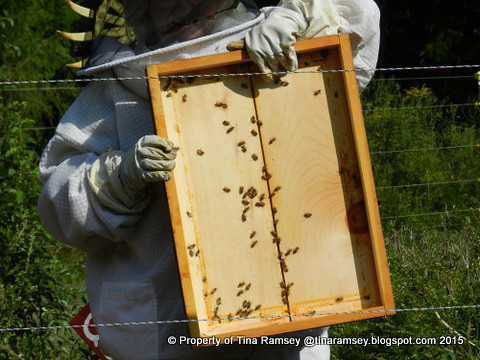 Remove the top cover (after you unstrap the hives--straps are important to keep the hives from blowing over in severe weather). Note all the bees? This is the strong hive and lots of bees are a good thing. Just be sure you have some protection from the bees. There is always one that gets kind of mad you are in their home and that one bee will persist in attacking you by stinging you if she can. My strong hive is the hive that has a bit more aggression issues than the weaker hive. I have gotten to the point of not smoking the bees and with experience I am getting better with hive checks. There is no school like the school of hard knocks and experience and with each check it seems to get easier.
Remove the top cover (after you unstrap the hives--straps are important to keep the hives from blowing over in severe weather). Note all the bees? This is the strong hive and lots of bees are a good thing. Just be sure you have some protection from the bees. There is always one that gets kind of mad you are in their home and that one bee will persist in attacking you by stinging you if she can. My strong hive is the hive that has a bit more aggression issues than the weaker hive. I have gotten to the point of not smoking the bees and with experience I am getting better with hive checks. There is no school like the school of hard knocks and experience and with each check it seems to get easier.
 The entry to the strong hive is full of bees busy going about their business. Right now they are loaded with a golden pollen and it is a delight to see. I always check the bees during the day when hopefully more workers are in the field (less bees to worry about bothering me) and when it is sunny outside with no rain predicted.
The entry to the strong hive is full of bees busy going about their business. Right now they are loaded with a golden pollen and it is a delight to see. I always check the bees during the day when hopefully more workers are in the field (less bees to worry about bothering me) and when it is sunny outside with no rain predicted.
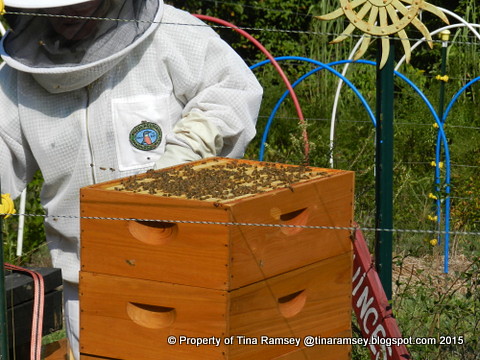 Once the top cover comes off I take off my top feeder (it's empty right now and not shown in the picture), then the inner cover and walah, I am in the hive proper. See the bees? They are working in one of the two supers (honey holding boxes), though there doesn't seem to be much honey in the supers.
Once the top cover comes off I take off my top feeder (it's empty right now and not shown in the picture), then the inner cover and walah, I am in the hive proper. See the bees? They are working in one of the two supers (honey holding boxes), though there doesn't seem to be much honey in the supers.
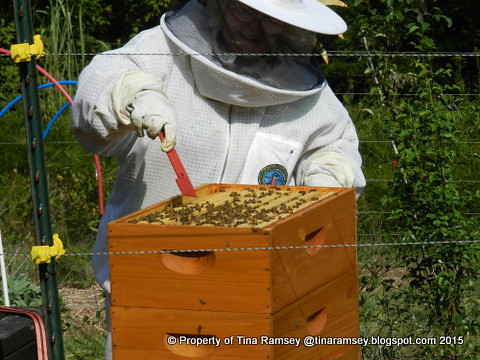 I get my hive tool and try really hard to pry the frames apart so I can remove one. It is a difficult feat to get those frames and boxes apart because the bees glue everything together with something called propolis. Propolis is good for the bees but not so good for the beekeeper. I think if I had to pick my most difficult task when checking the hives it would be to separate the boxes and frames without damaging them so that I can inspect everything.
I get my hive tool and try really hard to pry the frames apart so I can remove one. It is a difficult feat to get those frames and boxes apart because the bees glue everything together with something called propolis. Propolis is good for the bees but not so good for the beekeeper. I think if I had to pick my most difficult task when checking the hives it would be to separate the boxes and frames without damaging them so that I can inspect everything.
 Aha! One frame removed. I am now checking for honey and drawn comb since this is a honey super and not a brood box. There is some honeycomb on this frame but not as much as I'd like.
Aha! One frame removed. I am now checking for honey and drawn comb since this is a honey super and not a brood box. There is some honeycomb on this frame but not as much as I'd like.
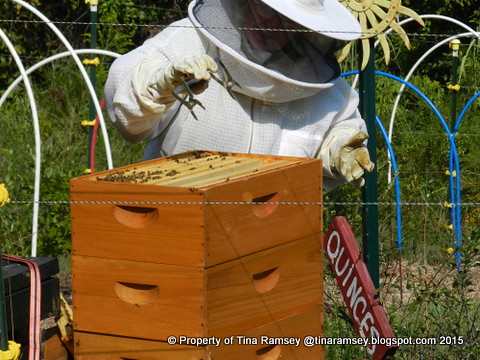 I will sit the first frame down in a safe place on my table then proceed to pull the other frames using my handy frame puller (the steel pinchers you see there). The frame puller is great! I just have to remember to keep a tight grip on it so that I don't drop any frames. When you drop frames the bees get mad and if you drop the frames on grass or the ground the frames will pick up dirt and grass because the propolis just loves debris. This is not a good thing for your beehive.
I will sit the first frame down in a safe place on my table then proceed to pull the other frames using my handy frame puller (the steel pinchers you see there). The frame puller is great! I just have to remember to keep a tight grip on it so that I don't drop any frames. When you drop frames the bees get mad and if you drop the frames on grass or the ground the frames will pick up dirt and grass because the propolis just loves debris. This is not a good thing for your beehive.
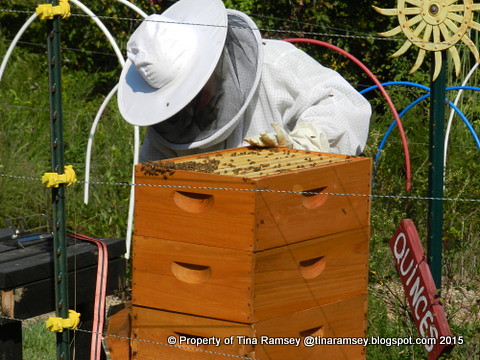 I don't always go through all frames in all boxes but I do try to look for pests, drawn comb, honey stores, and eventually brood once I get lower in the hive.
I don't always go through all frames in all boxes but I do try to look for pests, drawn comb, honey stores, and eventually brood once I get lower in the hive.
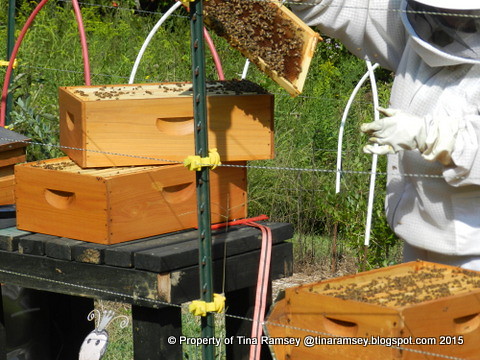 Here I've pulled both honey supers and am getting into the first of two deep brood boxes. These two boxes are theoretically where the queen should be located. In the better than four months I've had the bees I have never found a queen in either hive. One time Mr. Fix-it and my daughter Liz spotted one of the queens and that was exciting for us. It's okay if I don't spot the queen because as long as I find brood and eggs I think I'm doing okay and the queen is also okay.
Here I've pulled both honey supers and am getting into the first of two deep brood boxes. These two boxes are theoretically where the queen should be located. In the better than four months I've had the bees I have never found a queen in either hive. One time Mr. Fix-it and my daughter Liz spotted one of the queens and that was exciting for us. It's okay if I don't spot the queen because as long as I find brood and eggs I think I'm doing okay and the queen is also okay.
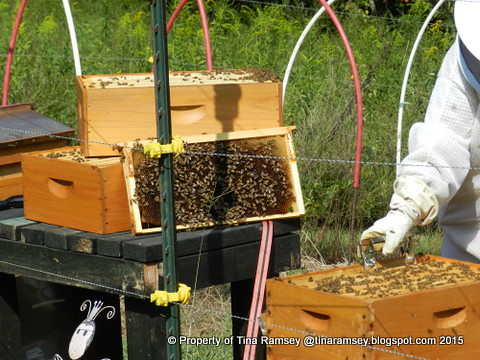 Can you see how dark this frame is? As compared to the frame above that came out of the honey super? The darkness comes from multiple bees hatching out and leaving behind their pupal skin. Apparently they leave behind some skin which attracts wax moths. So far I do not have any problems with wax moths or any other pests of beehives. I am absolutely thrilled this is the case--thus far.
Can you see how dark this frame is? As compared to the frame above that came out of the honey super? The darkness comes from multiple bees hatching out and leaving behind their pupal skin. Apparently they leave behind some skin which attracts wax moths. So far I do not have any problems with wax moths or any other pests of beehives. I am absolutely thrilled this is the case--thus far.
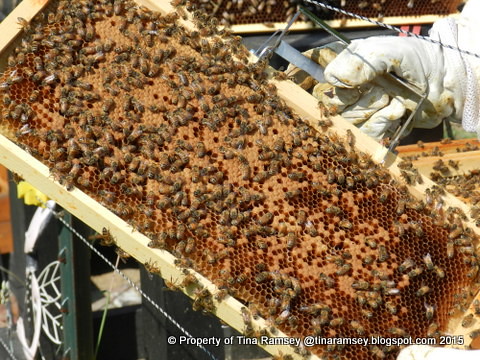 Here is an up close of a frame. I am running eight frame hives. The other type you can run are ten frame hives. The brood boxes in my hives are deeps. As you can imagine these boxes can get heavy so that is why I opted for eight frame hives versus the ten frame hives. Also, my hives are small cell frames. Bees can be large and some small. The natural way of bees is to be smaller but with breeding folks have tried to increase the bees size to presumably get more honey from larger bees. Some feel this works and others don't. I went with the smaller cells because bees are naturally small celled and I am trying to run my apiary as near to nature as I can.
Here is an up close of a frame. I am running eight frame hives. The other type you can run are ten frame hives. The brood boxes in my hives are deeps. As you can imagine these boxes can get heavy so that is why I opted for eight frame hives versus the ten frame hives. Also, my hives are small cell frames. Bees can be large and some small. The natural way of bees is to be smaller but with breeding folks have tried to increase the bees size to presumably get more honey from larger bees. Some feel this works and others don't. I went with the smaller cells because bees are naturally small celled and I am trying to run my apiary as near to nature as I can.
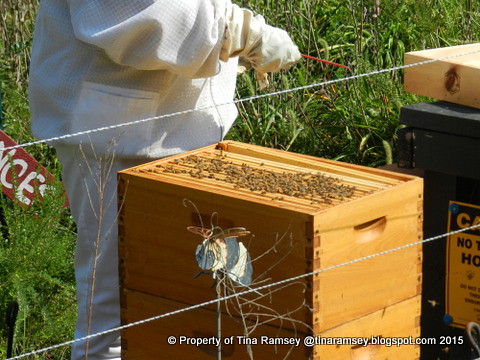 Getting into the weaker hive is a lot less stressful because there are not as many bees and because these bees are nicer. After removing the top cover, the feeder, and the inner cover this is the amount of bees I find. As compared to the stronger hive this is a stark difference in bee numbers. Checking this hive goes a lot faster and I am quite happy to find brood on the frames.
Getting into the weaker hive is a lot less stressful because there are not as many bees and because these bees are nicer. After removing the top cover, the feeder, and the inner cover this is the amount of bees I find. As compared to the stronger hive this is a stark difference in bee numbers. Checking this hive goes a lot faster and I am quite happy to find brood on the frames.
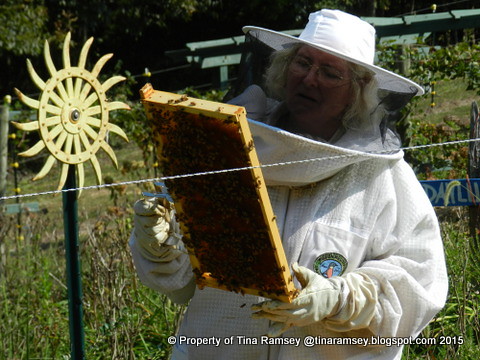 Observing the bees and the baby bees is really fascinating. You can hardly tell it is 90 degrees and I am wearing multiple layers of clothing can you? As much as I am fascinated by the bees I try to do my business and get out of the suit just as fast as I can. The whole process takes me about 45 minutes and it sometimes seems like it is over in two minutes! I check my hives about every two weeks and other than feeding them for about a week in the spring and also about a week last month I have not added anything to the hives nor have I tried to manipulate things. I guess I am lucky the bees have done well. As the days are getting shorter and the temperature begins to drop I am very worried about what winter will bring but for now this is a day in the beehive during the summer....
Observing the bees and the baby bees is really fascinating. You can hardly tell it is 90 degrees and I am wearing multiple layers of clothing can you? As much as I am fascinated by the bees I try to do my business and get out of the suit just as fast as I can. The whole process takes me about 45 minutes and it sometimes seems like it is over in two minutes! I check my hives about every two weeks and other than feeding them for about a week in the spring and also about a week last month I have not added anything to the hives nor have I tried to manipulate things. I guess I am lucky the bees have done well. As the days are getting shorter and the temperature begins to drop I am very worried about what winter will bring but for now this is a day in the beehive during the summer....
in the garden....
Words and Photos Property of In the Garden Blog Team, In the Garden
 The garden season is in full swing now so I thought I'd share some pictures from my current garden. I have been pretty busy getting the new garden to be ready and even have some gardens out there now. It has been fun but very time consuming and slow going. In the meantime I will enjoy this garden that I have come to love so very much.
Hollyhocks are not a favorite plant of mine but I allow a few of them to grow. They look nice right up until the point they get rust and flea beetles. Fortunately they self seed themselves and grow on their own with little help for me or I would not have any here.
The garden season is in full swing now so I thought I'd share some pictures from my current garden. I have been pretty busy getting the new garden to be ready and even have some gardens out there now. It has been fun but very time consuming and slow going. In the meantime I will enjoy this garden that I have come to love so very much.
Hollyhocks are not a favorite plant of mine but I allow a few of them to grow. They look nice right up until the point they get rust and flea beetles. Fortunately they self seed themselves and grow on their own with little help for me or I would not have any here.
 This garden is a very happy garden. The area slopes down so I planted taller plants in the low area. The effect is undulating and pleasing when looking at it from above and even from below since you look up at the plants. In another month or so the garden will be filled with the blooms of 'Limelgiht'. Right now it sports some rose campion, daylilies, astilbe, 'Annabelles', oakleafs, the wine bottles, and Asiatic lilies.
This garden is a very happy garden. The area slopes down so I planted taller plants in the low area. The effect is undulating and pleasing when looking at it from above and even from below since you look up at the plants. In another month or so the garden will be filled with the blooms of 'Limelgiht'. Right now it sports some rose campion, daylilies, astilbe, 'Annabelles', oakleafs, the wine bottles, and Asiatic lilies.
 The Sunny Perennial Border is strutting its stuff in the form of knockout roses, grasses, and other various perennials like daylilies, crinums, phlox, and coneflowers.
The Sunny Perennial Border is strutting its stuff in the form of knockout roses, grasses, and other various perennials like daylilies, crinums, phlox, and coneflowers.
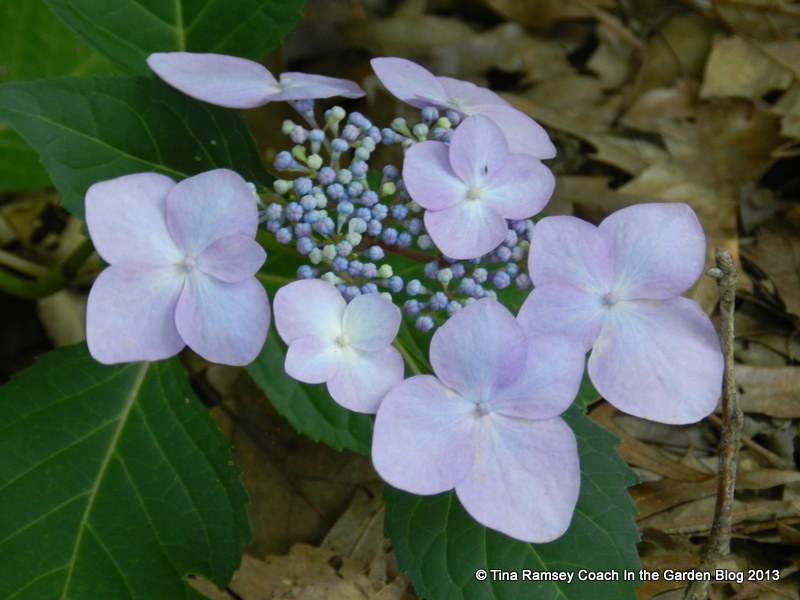 June also means it is hydrangea time! The one pictured above is 'Bluebird' and I am really liking the bloom because it is quite large. I grow a lot of hydrangeas but have been busy moving them to the new garden. This one will leave after our house is built. So far I have moved about a dozen PG hydrangeas and about eight oakleaf hydrangeas. The PGs are doing wonderfully and I suspect they will bloom this year. They line our long driveway on the edge of the field. I'll post a picture if they bloom. The oakleafs are struggling. I had to raise up their garden bed so Mr. Fix-it helped by using his tractor to scoop soil to surround the oakleaf hedge. I then edged the garden with rocks I moved from here. Oakleafs are one of those hydrangeas that simply will not do well if they are left to grow in standing water. My soil out there does drain well but it is rather heavy so I decided to raise their bed. Moving any shrubs in the spring is iffy business since I have no way to water them in the summer but so far this year has been awesome for rain. The plants will have to hold their own and I'll help as much as I can. I did move several large crepe myrtles. I find it vital to move crepe myrtles in the spring because it seems that if they are planted in the fall they will get lots of cold injury. The crepe myrtles are doing well-four out of the five are anyhow.
June also means it is hydrangea time! The one pictured above is 'Bluebird' and I am really liking the bloom because it is quite large. I grow a lot of hydrangeas but have been busy moving them to the new garden. This one will leave after our house is built. So far I have moved about a dozen PG hydrangeas and about eight oakleaf hydrangeas. The PGs are doing wonderfully and I suspect they will bloom this year. They line our long driveway on the edge of the field. I'll post a picture if they bloom. The oakleafs are struggling. I had to raise up their garden bed so Mr. Fix-it helped by using his tractor to scoop soil to surround the oakleaf hedge. I then edged the garden with rocks I moved from here. Oakleafs are one of those hydrangeas that simply will not do well if they are left to grow in standing water. My soil out there does drain well but it is rather heavy so I decided to raise their bed. Moving any shrubs in the spring is iffy business since I have no way to water them in the summer but so far this year has been awesome for rain. The plants will have to hold their own and I'll help as much as I can. I did move several large crepe myrtles. I find it vital to move crepe myrtles in the spring because it seems that if they are planted in the fall they will get lots of cold injury. The crepe myrtles are doing well-four out of the five are anyhow.
 This is My Mother's Hydrangea. I got cuttings from Maine in the winter and was able to propagate this one hydrangea. It is getting quite large now after ten years. It will for sure be moving with me after the house is built. I find these kinds of hydrangeas (H. macrophylla) do much better when planted near the house and not out in the garden on their own.
Do you want a tip to help keep your hydrangeas looking blue? My husband loves pickles and can sometimes eat a lot of them. Being a recycler I hate to just throw away the leftover pickle juice so I decided to pour the leftover juice on this hydrangea. I only poured it on the hydrangea when rain was imminent in order to dilute the vinegar (the base for most pickle juices) a bit. You all do know that blue hydrangeas come from an acid soil right? And vinegar is an acid so it helps to make the hydrangeas blue. Well, there's my secret to blue hydrangeas--pickle juice--it really helps! You heard it here first!
This is My Mother's Hydrangea. I got cuttings from Maine in the winter and was able to propagate this one hydrangea. It is getting quite large now after ten years. It will for sure be moving with me after the house is built. I find these kinds of hydrangeas (H. macrophylla) do much better when planted near the house and not out in the garden on their own.
Do you want a tip to help keep your hydrangeas looking blue? My husband loves pickles and can sometimes eat a lot of them. Being a recycler I hate to just throw away the leftover pickle juice so I decided to pour the leftover juice on this hydrangea. I only poured it on the hydrangea when rain was imminent in order to dilute the vinegar (the base for most pickle juices) a bit. You all do know that blue hydrangeas come from an acid soil right? And vinegar is an acid so it helps to make the hydrangeas blue. Well, there's my secret to blue hydrangeas--pickle juice--it really helps! You heard it here first!
 You are actually looking at four gardens in this view. It looks kind of like one large one doesn't it? The Asiatic lilies grace a small garden next to an arbor, behind it is my Sidewalk garden with all sorts of frilly things, then the Front Center Garden shows its stuff with the tall bearded irises, and finally the Roadside Garden brings up the rear with its backbone of shrubs. Directly on the other side of the Roadside Garden is the road. The trick to making gardens look so full and front and center is to layer them. Between each of these gardens are wide grass pathways. If I were to post a winter picture you'd understand better but I just wanted you to know this is not one large garden.This is the view visitors get as they approach my front sidewalk. I never tire of it when I park my car either.
You are actually looking at four gardens in this view. It looks kind of like one large one doesn't it? The Asiatic lilies grace a small garden next to an arbor, behind it is my Sidewalk garden with all sorts of frilly things, then the Front Center Garden shows its stuff with the tall bearded irises, and finally the Roadside Garden brings up the rear with its backbone of shrubs. Directly on the other side of the Roadside Garden is the road. The trick to making gardens look so full and front and center is to layer them. Between each of these gardens are wide grass pathways. If I were to post a winter picture you'd understand better but I just wanted you to know this is not one large garden.This is the view visitors get as they approach my front sidewalk. I never tire of it when I park my car either.
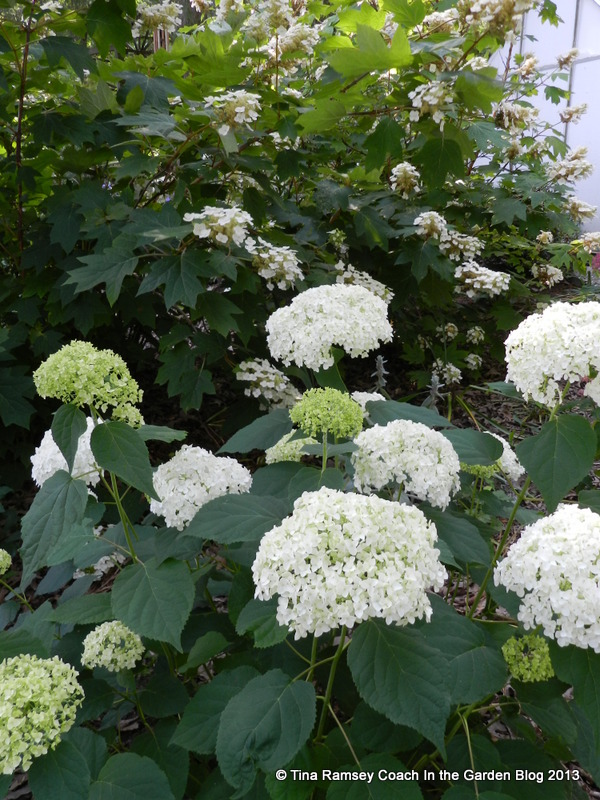 These hydrangeas are of two different varieties. In the front with the round fluffly balls are the 'Annabelle' (Hydrangeas arborescens) and behind the Annabelles are the oakleaf hydrangeas (Hydrangeas quercifolia). Some Hydrangea paniculatas are blooming but the big show with the paniculatas (PG and Limelight and a few others) will be in another month or so.
These hydrangeas are of two different varieties. In the front with the round fluffly balls are the 'Annabelle' (Hydrangeas arborescens) and behind the Annabelles are the oakleaf hydrangeas (Hydrangeas quercifolia). Some Hydrangea paniculatas are blooming but the big show with the paniculatas (PG and Limelight and a few others) will be in another month or so.
 'Raspberry Profusion' abelia is a bee magnet. I like the abelias because they are native, easy to grow, and bloom for a very long time....
'Raspberry Profusion' abelia is a bee magnet. I like the abelias because they are native, easy to grow, and bloom for a very long time....
in the June garden....
Words and Photos Property of In the Garden Blog Team, In the Garden



































